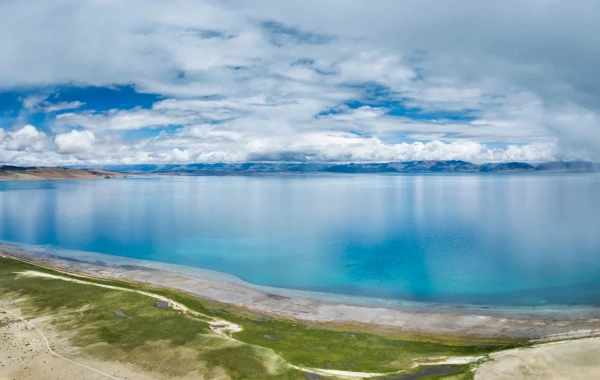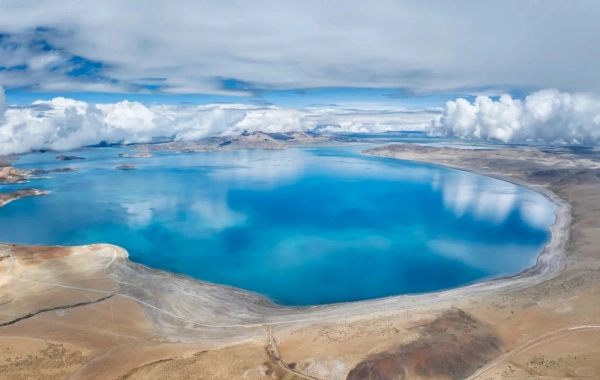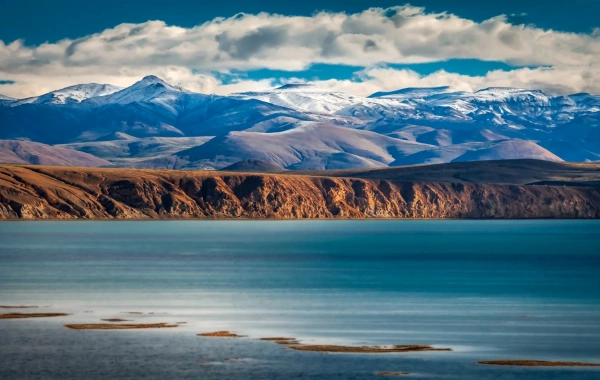Lake Manasarovar
Lake Manasarovar, also known as Mapam Yumco, is one of the most sacred and highest freshwater lakes in the world, nestled in the Tibetan Plateau at an elevation of approximately 4,590 meters. Revered in Hinduism, Buddhism, Jainism, and Bon religions, it symbolizes purity and spiritual awakening. With a circumference of about 88 kilometers and a maximum depth of 90 meters, the lake is surrounded by breathtaking mountain scenery, including Mount Kailash to the north. Its crystal-clear waters and serene atmosphere attract pilgrims and travelers seeking both physical and spiritual rejuvenation. Designated as a protected area, Lake Manasarovar remains a timeless testament to nature's beauty and humanity's quest for transcendence.

Historical and Religious Significance
Lake Manasarovar holds profound religious importance across multiple faiths. In Hinduism, it is believed to be the abode of Lord Shiva and the source of four major rivers: the Indus, Sutlej, Brahmaputra, and Karnali. Buddhists associate it with Amitabha Buddha and consider circumambulating the lake a sacred ritual. Jains revere it as the site where their first tirthankara, Rishabhanatha, attained enlightenment, while the Bon tradition links it to the sky goddess Sherab Chamma. Historical records mention pilgrimages dating back to the 7th century, with figures like Xuanzang documenting its significance. The lake's name, derived from Sanskrit "Manasa Sarovara" (Mind Lake), reflects its role as a mirror to the soul.
Geographical Features
Lake Manasarovar is oval-shaped, spanning roughly 320 square kilometers, with its northern shore bordered by Mount Kailash (6,638 meters), a sacred peak in its own right. The lake’s waters are notably transparent, with visibility extending to depths of 14 meters, and they remain ice-covered from mid-November to mid-April. Fed by melting snow and underground springs, it drains into the Ghaghara River via the Ganga Chhu stream. The surrounding landscape includes the Rakshastal Lake, a nearby saltwater lake considered inauspicious in contrast to Manasarovar’s purity. The region’s harsh climate features extreme temperature variations, from -15°C in winter to 20°C in summer.

Major Attractions
- Mount Kailash: Though not part of the lake itself, its proximity makes Kailash a focal point for pilgrims, who often combine circumambulation of both the mountain (kora) and the lake.
- Chiu Gompa Monastery: A Tibetan Buddhist monastery perched on the lake’s northern shore, offering stunning views and a tranquil spot for meditation.
- Trugsa Beach: A serene sandy stretch on the eastern shore, ideal for quiet contemplation and witnessing sunrise over the lake.
- Gyangdrak Hot Springs: Natural thermal springs located nearby, believed to have healing properties and frequented by pilgrims for ritual purification.
- Rakshastal Lake: The “Demon Lake” to the west, separated from Manasarovar by a narrow isthmus, symbolizing the duality of good and evil in local lore.
- Lha-Tso and Ma-Tso Lakes: Two smaller sacred lakes near Manasarovar, associated with compassion and wisdom in Tibetan Buddhism.
Suggested Itineraries
- Short Visit (1–2 Days):
- Day 1: Arrive at Chiu Gompa, explore the monastery, and circumambulate the lake (a 3-day trek covering 90 km). Alternatively, walk a shorter 12 km circuit around Chiu Gompa.
- Day 2: Visit Trugsa Beach for sunrise, then travel to nearby hot springs for relaxation.
Highlights: Spiritual immersion, natural beauty, and cultural insights.
- Extended Pilgrimage (5–7 Days):
- Day 1–3: Combine the Manasarovar kora with a visit to Mount Kailash’s base camp at Darchen.
- Day 4: Trek to the sacred Dirapuk Monastery near Kailash’s north face.
- Day 5–6: Continue to Zutrulpuk Monastery via the Dolma La Pass (5,630 meters), the highest point of the kora.
- Day 7: Return to Manasarovar for reflection and departure.
Highlights: Deep spiritual journey, high-altitude trekking, and cultural monuments.
- Cultural Exploration (3–4 Days):
- Day 1: Tour Chiu Gompa and nearby villages to learn about Tibetan life.
- Day 2: Visit Lha-Tso and Ma-Tso Lakes for rituals and photography.
- Day 3: Explore Rakshastal Lake and its mythological significance.
- Day 4: Attend a puja (prayer ceremony) at Chiu Gompa and interact with monks.
Highlights: Cultural interactions, photography, and understanding local traditions.

Permit and Logistics
- Permits: Foreign travelers require a Tibet Travel Permit, Alien’s Travel Permit, and Military Permit to visit Lake Manasarovar. These must be arranged through a registered tour operator in advance.
- Guided Tours: Due to the remote location and permit restrictions, most visitors join organized tours from Lhasa or Kathmandu, which include Transportation, accommodation, and permits.
- Accommodation: Basic guesthouses and tented camps are available near Chiu Gompa and Darchen. Facilities are rudimentary, with limited electricity and heating.
- Best Time to Visit: May to October, when roads are accessible and temperatures are milder. The Kailash Mansarovar Yatra, a government-sponsored pilgrimage, operates during this period.
Transportation
- By Air: The nearest Airport is in Ngari Gunsa, about 500 km away, with limited flights from Lhasa or Kathmandu. From there, a 2-day drive is required.
- By Road: The most common route is via Lhasa to Shigatse, then to Saga County (4,500 km from Lhasa), and finally to Lake Manasarovar (a 4–5 hour drive from Saga). Alternatively, travelers can fly to Kathmandu and join a tour crossing the Nepal-Tibet border at Rasuwagadhi.
- Local Transport: Jeeps or buses are used for overland journeys, while within the region, horses or yaks may be hired for trekking.

Best Time & Tips
- Peak Season: May to October offers the best weather, but crowds peak in June–August during the Kailash Mansarovar Yatra.
- Avoid Crowds: Visit in May or late September–October for fewer tourists.
- Weather: Days are warm (15–20°C), but nights are cold (below 0°C). Pack layers, a down jacket, and waterproof gear.
- Essentials:
- Acclimatize in Lhasa or Shigatse for 2–3 days before ascending to higher altitudes.
- Carry sunscreen, sunglasses, and a hat to protect against strong UV radiation.
- Respect local customs: ask permission before photographing people or religious sites, and avoid touching monks or prayer flags.
- Prohibited items: Drones, satellite phones, and political literature. Smoking and littering are strictly forbidden near the lake.
- Environmental tip: Carry out all trash to preserve the lake’s purity.
Nearby attractions
Recommened Itinerary
China Pilgrimage Adventure Tour
If you would like to ask more questions about attractions or have a personalized itinerary, please contact usIf you would like to ask more questions about attractions or have a personalized itinerary, please contact us
Contact Us
What Our Clients Say?
Based on 10,000+ traveler reviews













